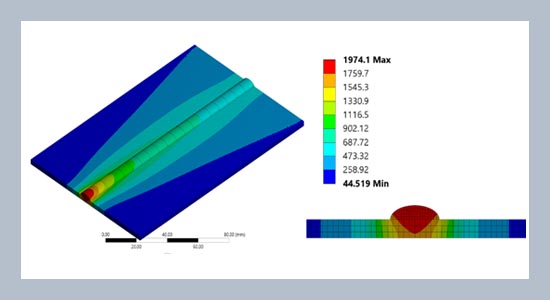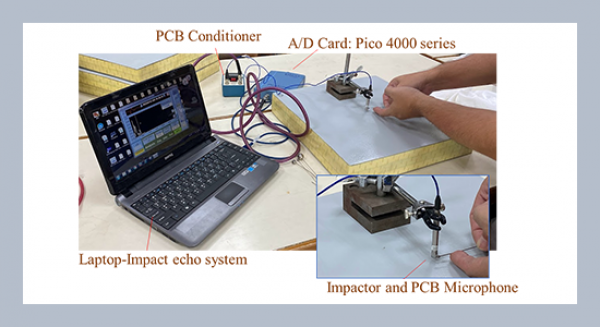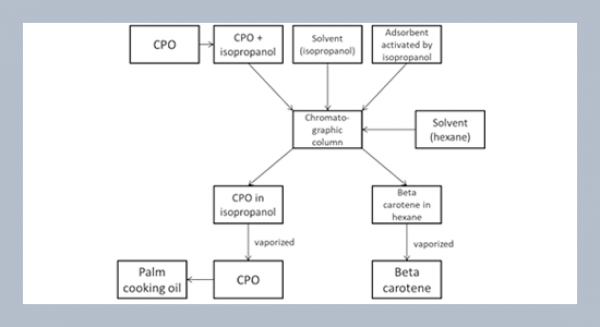REFERENCES
- A. S. of M. (ASM) 1993. Welding, brazing, and soldering. Mechanical Design, 6, 155–155. https://doi.org/10.3138/9781487579890-121
- Ambriz, R.R., Jaramillo, D. 2014. Mechanical behavior of precipitation hardened aluminum alloys welds. Light Metal Alloys Applications, (Fig. 1). https://doi.org/10.5772/58418
- Amudha, A., Nagaraja, H.S., Shashikala, H.D. 2019. Finite element analysis of thermal residual stresses in SS-309Mo and Inconel-625 multilayer weld deposition on low carbon steel. International Journal of Fatigue, 127, 338–344. https://doi.org/10.1016/j.ijfatigue.2019.06.014
- Ansys. (n.d.) 2020. Ansys ACT The fastest, easiest way to tailor your simulation workflows. Retrieved April 15, from https://www.ansys.com/products/structures/ansys-act
- Asserin, O., Loredo, A., Petelet, M., Iooss, B. 2011. Global sensitivity analysis in welding simulations - What are the material data you really need? Finite Elements in Analysis and Design, 47, 1004–1016. https://doi.org/10.1016/j.finel.2011.03.016
- B. S. E. N. 1999‐1‐2: (2007) 2007. Eurocode 9‐Design of aluminium structures‐Part 1‐2: Structural fire design.
- Bajpei, T., Chelladurai, H., Ansari, M.Z. 2016. Numerical investigation of transient temperature and residual stresses in thin dissimilar aluminium alloy plates. Procedia Manufacturing, 5, 558–567. https://doi.org/10.1016/j.promfg.2016.08.046
- Balram, Y., Rajyalakshmi, G. 2019. Thermal fields and residual stresses analysis in TIG weldments of SS 316 and Monel 400 by numerical simulation and experimentation. Materials Research Express, 6. https://doi.org/10.1088/2053-1591/ab23cf
- Bansal, A., Senthil Kumar, M., Shekhar, I., Chauhan, S., Bhardwaj, S. 2020. Effect of welding parameter on mechanical properties of TIG welded AA6061. Materials Today: Proceedings, (xxxx). https://doi.org/10.1016/j.matpr.2020.07.567
- Cezario, C.A., Bork, B.C., Verardi, M., Santos, J.R. 2014. Robust electric machine design through multiphysics. Ansys Inc., VIII, 11–15.
- Chiocca, A., Frendo, F., Bertini, L. 2019. Evaluation of heat sources for the simulation of the temperature distribution in gas metal arc welded joints. Metals, 9. https://doi.org/10.3390/met9111142
- Darmadi, D.B., Kiet-Tieu, A., Norrish, J. 2014. A validated thermo mechanical FEM model of bead-on-plate welding. International Journal of Materials and Product Technology, 48, 146–166. https://doi.org/10.1504/IJMPT.2014.059047
- Darmadi, D.B., Norrish, J., Tieu, A.K. 2011. Analytic and finite element solutions for temperature profiles in welding using varied heat source models. World Academy of Science, Engineering and Technology, 81, 154–162.
- Deng, D., Murakawa, H., Liang, W. 2007. Numerical simulation of welding distortion in large structures. Computer Methods in Applied Mechanics and Engineering, 196, 4613–4627. https://doi.org/10.1016/j.cma.2007.05.023
- E. N. 1993-1-2: (2005) 2005. Eurocode 3–Design of steel structures–Part 1–2: General Rules–Structural fire design.
- Feng, Z. 2005. Processes and mechanisms of welding residual stress and distortion. Elsevier.
- Friedman, E. 1975. Thermomechanical analysis of the welding process using the finite element method. Journal of Pressure Vessel Technology, Transactions of the ASME, 97, 206–213. https://doi.org/10.1115/1.3454296
- Ganesh, K.C., Vasudevan, M., Balasubramanian, K.R., Chandrasekhar, N., Mahadevan, S., Vasantharaja, P., Jayakumar, T. 2014. Modeling, prediction and validation of thermal cycles, residual stresses and distortion in type 316 LN stainless steel WELD joint made by TIG welding process. Procedia Engineering, 86, 767–774. https://doi.org/10.1016/j.proeng.2014.11.096
- Goldak, J., Chakravarti, A., Bibby, M. 1984. A new finite element model for welding heat sources. Metallurgical Transactions B, 15, 299–305.
- Guilherme, L.H., Benedetti, A.V., Fugivara, C.S., Magnabosco, R., Oliveira, M.F. 2020. Effect of MAG welding transfer mode on sigma phase precipitation and corrosion performance of 316L stainless steel multi-pass welds. Journal of Materials Research and Technology, 9, 10537–10549. https://doi.org/10.1016/j.jmrt.2020.07.039
- Kik, T., Górka, J. 2019. Numerical simulations of laser and hybrid S700MC T-joint welding. Materials, 12. https://doi.org/10.3390/ma12030516
- Knoedel, P., Gkatzogiannis, S., Ummenhofer, T. 2017. Practical aspects of welding residual stress simulation. Journal of Constructional Steel Research, 132, 83–96. https://doi.org/10.1016/j.jcsr.2017.01.010
- Komanduri, R., Hou, Z.B. 2000. Thermal analysis of the arc welding process: Part I. General solutions. Metallurgical and Materials Transactions B: Process Metallurgy and Materials Processing Science, 31, 1353–1370. https://doi.org/10.1007/s11663-000-0022-2
- Kumar, P., Kumar, R., Arif, A., Veerababu, M. 2020. Investigation of numerical modelling of TIG welding of austenitic stainless steel (304L). Materials Today: Proceedings, 27, 1636–1640. https://doi.org/10.1016/j.matpr.2020.03.544
- Kumar, P., Sinha, A.N. 2018. Studies of temperature distribution for laser welding of dissimilar thin sheets through finite element method. Journal of the Brazilian Society of Mechanical Sciences and Engineering, 40. https://doi.org/10.1007/s40430-018-1380-5
- Lahtinen, T., Vilaça, P., Infante, V. 2019. Fatigue behavior of MAG welds of thermo-mechanically processed 700MC ultra high strength steel. International Journal of Fatigue, 126, 62–71. https://doi.org/10.1016/j.ijfatigue.2019.04.034
- Nasiri, M.B., Enzinger, N. 2019. Powerful analytical solution to heat flow problem in welding. International Journal of Thermal Sciences, 135, 601–612. https://doi.org/10.1016/j.ijthermalsci.2018.08.003
- Nguyen, N.T., Ohta, A., Matsuoka, K., Suzuki, N., Maeda, Y. 1999. Analytical solutions for transient temperature of semi-infinite body subjected to 3-D moving heat sources. Welding Journal (Miami, Fla), 78.
- Rosenthal, D. 1946. The theory of moving sources of heat and its application of metal treatments. Transactions of ASME, 68, 849–866.
- Vairamani, V., Mohan, N., Venkatesh, Karthikeyan, S.K., Sakthivel, M. 2020. Optimization and microstructure analysis of Corten steel joint in mag welding by post heat treatment. Materials Today: Proceedings, 21, 673–680. https://doi.org/10.1016/j.matpr.2019.06.737
- Velaga, S.K., Ravisankar, A. 2017. Finite element based parametric study on the characterization of weld process moving heat source parameters in austenitic stainless steel. International Journal of Pressure Vessels and Piping, 157, 63–73. https://doi.org/10.1016/j.ijpvp.2017.09.001
- Venkatkumar, D., Ravindran, D. 2019. Effect of boundary conditions on residual stresses and distortion in 316 stainless steel butt welded plate. High Temperature Materials and Processes, 38, 827–836. https://doi.org/10.1515/htmp-2019-0048
- Vicente, T.A., Oliveira, L.A., Correa, E.O., Barbosa, R.P., Macanhan, V.B.P., de Alcântara, N.G. 2018. Stress corrosion cracking behaviour of dissimilar welding of AISI 310S austenitic stainless steel to 2304 duplex stainless steel. Metals, 8. https://doi.org/10.3390/met8030195
- Wang, L., Chen, J., Wu, C., Luan, S. 2020. Numerical analysis of arc and droplet behaviors in gas metal arc welding with external compound magnetic field. Journal of Materials Processing Tech., 116638. https://doi.org/10.1016/j.jmatprotec.2020.116638
- Wang, X., Xiao, Y., Gao, N., Liang, L., Lu, C., Jiang, H. 2019. A semi-analytical solution of three-dimensional transient temperature field for a uniform plate subjected to Gaussian-distribution laser heat source. Thermal Science, 268–268. https://doi.org/10.2298/tsci190102268w
- Winczek, J. 2017. Modeling of temperature field during multi-pass gmaw surfacing or rebuilding of steel elements taking into account the heat of the deposit metal. Applied Sciences (Switzerland), 7. https://doi.org/10.3390/app7010006
- Zuo, S., Wang, Z., Wang, D., Du, B., Cheng, P., Yang, Y. Lang, N. 2020. Numerical simulation and experimental research on temperature distribution of fillet welds. Materials, 13. https://doi.org/10.3390/ma13051222















